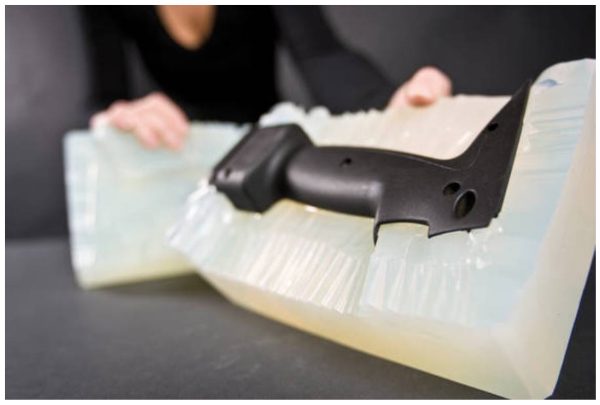What is Vacuum Casting?
Vacuum casting prototyping uses this process as stated by Wikipedia: “The process starts by placing a two-piece silicone mold in a vacuum chamber. The raw material is mixed with degassed and then poured into the mold. The vacuum is then released, and the mold is removed from the chamber. Finally, the casting is cured in an oven and the mold is removed to release the completed casting. The silicone mold can be reused.”

The 4-step process of vacuum casting prototyping polyurethane items
The process of creating a vacuum casting polyurethane can be broken down into four steps:
Step 1 – Create the master model of the final part that needs to be cast, this is often created via CNC machining or an SLS/SLS models.
Step 2 – The master model is suspended in a container and liquid silicone is poured into the container and left to cure. Once the silicone is cured inside a heated chamber, it is carefully cut in half revealing the master model which is removed from the silicone leaving a cavity.
Step 3 – This is where the parts are cast and are generally done by using two-part polyurethanes. The mixed polyurethane is poured into the vacuum casting silicone mold cavity and placed into a vacuum chamber which eliminates any air or gas bubbles. The part is then cured in a heating chamber.
Step 4 – Once the part has cured it is removed from the silicone tool and any flash is removed. Depending upon the material used to cast the part, it can be further cured in an oven.
You can see the process in action in this video (in our contract manufacturing subsidiary, Agilian Technology’s facility):
Advantages of Vacuum Casting Prototypes
Relatively high surface finishes achievable
- If the master model has the required surface finishes applied, the silicone mold will pick up every minute detail, therefore the molding parts will replicate the exact finish of the master model.
- A relatively high level of detail is achievable with molded parts. (However, since pressure is low, textures don’t always come out as nicely as in high-pressure injection molding.)
Low cost of tooling
- Prototyping often requires design iterations and low tooling cost is an advantage when multiple iterations are required.
- No long lead times to create hardened steel tools or the expenses associated with production injection mold tools.
Ideal for low quantities
- The silicone molds are reusable and are ideal for producing less than 100 items (ideal quantity is 20 parts), which is perfect for product testing and verification purposes.
Vacuum casting is not only economical for one-off units but also low quantity production runs for initial product testing or initial launch. Vacuum casting allows users to create a wide range of functional plastic prototypes. The whole process is relatively quick compared to other manufacturing processes and parts produced through vacuum casting are of high quality and better surface finish.
Examples of Vacuum Cast Parts
Some of the typical industries that utilize vacuum casting prototyping are:
- Aerospace
- Agriculture
- Automotive
- Electronics
- Hospitality
- Transportation
Here you can see a vacuum cast keypad prototype for an electronic device (such as a TV remote) which is being removed from the silicone mold and is ready for curing:




